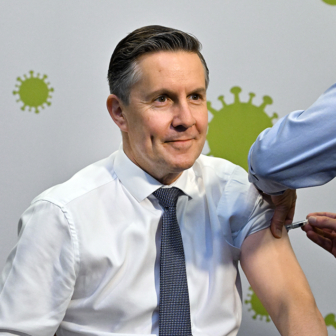It’s been one of the few times in my life that I’ve empathised with politicians being grilled on radio and TV. They’ve been trained to avoid answering direct questions: to be vague; to state the obvious when it has nothing to do with the question; to blame other people. Reporters, meanwhile, are trying for a gotcha moment.
With things so serious, and changing by the hour, the risk of falling into a gotcha moment is even greater. “But last week you told Australia we wouldn’t be restricting…” says the triumphant interviewer to the struggling politician who, for once, is trying to be honest and not avoid the question.
That’s because this pandemic is different. What politicians think is necessarily changing from day to day, and being responsible leaders they must rapidly adapt. The key to understanding Covid-19 is uncertainty.
The same uncertainty exists among health practitioners. When we try to predict the course of this disease in individuals we have little to go on. Same for the epidemiology. How quickly will it spread? How contagious is it? What measures can reduce the spread and what impact will they have? We can only make semi-informed estimates.
Behind us, we have the experience of the 1918 influenza epidemic, the SARS epidemic and other recent outbreaks, the Middle East respiratory syndrome coronavirus, other respiratory viral illnesses, and the lungs’ generic reaction to insults, known as adult respiratory distress syndrome (ARDS). But this coronavirus is different. So far, the smartest technology has little to offer.
This is where we need to rely on human beings rather than gadgets. Luckily, the international intensive care community has a long history of communicating well with each other through journals, conferences and direct contacts. I receive scores of personal communications every day sharing the experience of colleagues around the world.
We know the coronavirus is extremely contagious and has a higher mortality than normal influenza. It mainly affects adults, and the severe cases are usually among people over the age of seventy and those with chronic health conditions.
This means that normal hospital beds have little or nothing to offer the majority of sufferers — unless it is to enforce isolation, as authorities have done in Singapore. Until the disease progresses, we have no specific treatment; once it does, patients will usually be admitted to an intensive care unit, where the aim is to keep them alive while their bodies mobilise their defences and defeat the virus. Of all the cases of Covid-19 so far, between 5 per cent and 16 per cent have reportedly become serious enough to require admission to an ICU. Those figures are subject to uncertainty, of course, but for planning purposes they give Australian hospitals some indication of the task ahead.
This pandemic has encouraged an even greater sharing of information among intensivists across the world. So far, the information has come mainly from colleagues in China and Italy. As I write, the most cited intensive care journal in the world, Intensive Care Medicine, has just published up-to-date guidelines put together by thirty-six experts based on experience so far. Some of the most helpful information has come from Lombardy, a region in northern Italy. The epidemic has been especially grave in Italy. Intensive care is very well developed there and Milan has been at the forefront of how to treat severe lung disease using optimal artificial ventilation strategies.
Our lungs consist of large and small airways leading to millions of tiny air sacks, or alveoli, where gas exchange occurs. In certain patients, the virus attacks the alveoli. When the body defends itself by mobilising the cells and chemicals that fight the virus, an inflammatory response occurs and fluid pours into the alveoli. This is the same process that occurs in the upper respiratory tract, causing a runny nose; in the case of the alveoli, though, the consequences are far more dangerous. An alveolus full of fluid can’t take up oxygen and excrete carbon dioxide, and so the patient gradually becomes hypoxic, or short of oxygen. Trying to move the heavy lungs up and down, he or she becomes increasingly distressed.
If you are unfortunate enough to be in this situation you will be admitted to hospital and most likely to intensive care. The staff treating you will be dressed in personal protection equipment: a special mask if performing procedures, otherwise an ordinary surgical mask, gloves, gown and a face shield or special goggles. The ICU will be divided into a treating environment, a donning area (for putting equipment on), a doffing area (for taking it off) and a clean support area. Ideally, this will all occur in rooms with negative pressure to keep the pathogens isolated.
The severe bacterial infections common in ICUs often affect many organs in the body, including the heart, kidneys and liver. Circulation to these organs is severely disturbed and blood pressure drops, often requiring complex support for each vital organ. When an infection is accompanied by a decrease in blood pressure and abnormal circulation, it is known as shock, or — in cases where organisms are the cause — septic shock. Coronavirus may be different, with its major impact confined to the lungs, at least in people under fifty. But the data so far is variable, with some reports showing that other organs are affected in up to 35 per cent of patients, depending on their age and chronic health conditions.
ICU treatment can have some influence on the outcome of individual cases of Covid-19, but mortality will be largely determined by a patient’s age and underlying state of health. The first management strategy is to provide more oxygen to patients who are hypoxic. To provide more oxygen and assist breathing, oxygen can be delivered under pressure using specially sealed masks, called non-invasive ventilation, or NIV. This can be done in the emergency department or occasionally in specially configured wards of a general hospital. NIV is often all that is required when the patient is hypoxic.
But most hospitalised patients will rapidly become worse. A plastic tube will need to be placed in the windpipe, or trachea, and connected to a ventilator. To make ventilation more efficient and maximise oxygen delivery, most patients will need to be sedated and have their muscles paralysed. The aim is to maintain the body’s oxygen levels using ventilatory strategies while minimising damage to the lungs. This approach is well known to intensivists.
Of the 1503 patients recently treated in ICUs in Milan, 94 per cent were artificially ventilated and about one-fifth of those had to be “proned.” This involves turning patients onto their stomach, rather than having them sitting up, to improve ventilation and help correct the hypoxia. Of course, caring for patients in that position presents practical difficulties, but well-tried manoeuvres and strategies exist to optimise their care.
Despite optimal artificial ventilation, some patients continue to worsen and become more hypoxic. One more intervention is available: extracorporeal membrane oxygenation, or ECMO. Blood is taken out of the body and artificially oxygenated via a specially designed membrane before being returned to the body. ECMO devices are relatively scarce, and they require a considerable increase in staffing levels and expertise.
Using these approaches, very few Covid-19 patients under the age of fifty will die in the ICU. But what are the challenges for older patients, especially those with existing health problems and those over seventy, who are more likely to become critically ill? So far, regions with heavy caseloads have had to increase their number of ICU beds by moving to operating theatres, recovery areas and other parts of hospitals where the high technology is available. China and Italy have had to rapidly build new areas to accommodate ICU beds, and many countries face shortages of protective clothing, trained staff and ventilators.
With limited resources, will we need to triage patients who are older and already in very poor health, and therefore have a poor prognosis? Intensive care units around the world already do this. If patients near the end of life have little or no chance of recovery, it is generally considered inappropriate to place them on life-support machines.
Maurizio Cecconi, president-elect of the European Society of Intensive Care Medicine and a practising intensivist in Milan, has said that the triaging criteria for admitting patients to intensive care has not so far changed. The data from Milan show that many eighty- and even ninety-year-olds are being managed in ICUs.
But we are faced with the real possibility in Australia of not having enough beds, ventilators, staff and ECMO machines. What happens if a fit and otherwise well thirty-year-old is worsening and no bed or ventilator is available? In normal circumstances, even if my own hospital doesn’t have enough beds we can transfer a person to another hospital. The guidelines from the Australian and New Zealand Intensive Care Society suggest that admission criteria should reflect routine practice, and that similar criteria should apply across all jurisdictions and all patients. Whatever happens, we need to be transparent about the decision-making process and its justification in our dealings with other clinicians, patients and their families.
It is important to be aware that drugs have shown no impact on patients’ outcomes. It is always tempting to hope for a magic bullet, but so far none exists. What we do in intensive care is complex, requiring sophisticated technology, meticulous attention to detail, and team work, especially from nursing staff. It will be a matter of doing what we do every day as well as we can, and we in Australia are in a great position to do this. We are one of the leaders in the specialty of intensive care and provide care equal to or better than any other country. While we are confident that we will provide the best possible care, there is that word again — uncertainty. •




